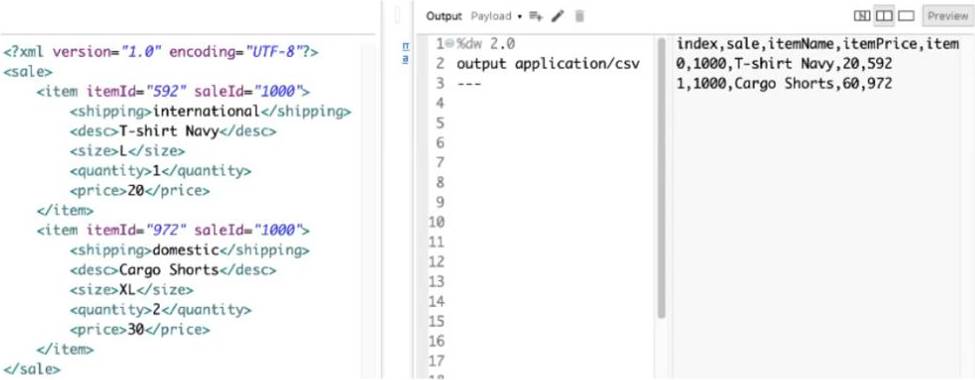Mulesoft MuleSoft Certified Developer-Level 1 MuleSoft Certified Developer-Level 1 (Mule 4) Online Training
Mulesoft MuleSoft Certified Developer-Level 1 Online Training
The questions for MuleSoft Certified Developer-Level 1 were last updated at Mar 01,2025.
- Exam Code: MuleSoft Certified Developer-Level 1
- Exam Name: MuleSoft Certified Developer-Level 1 (Mule 4)
- Certification Provider: Mulesoft
- Latest update: Mar 01,2025
What DataWeave expression transforms the example XML input to the CSV output?

A)

B)

C)

D)

- A . Option A
- B . Option B
- C . Option C
- D . Option D
A
Explanation:
Correct answer is as below. Attributes in the incoming xml payload are always accessed using @.Similarly *item is required as we have multiple items in the request %dw 2.0
output application/csv
—
payload.sale.*item map ((value, index) -> {
index: index,
sale: value.@saleId,
itemName: value.desc,
itemPrice: (value.quantity) * (value.price),
item: value.@itemId
} )
What DataWeave expression transforms the example XML input to the CSV output?

A)

B)

C)

D)

- A . Option A
- B . Option B
- C . Option C
- D . Option D
A
Explanation:
Correct answer is as below. Attributes in the incoming xml payload are always accessed using @.Similarly *item is required as we have multiple items in the request %dw 2.0
output application/csv
—
payload.sale.*item map ((value, index) -> {
index: index,
sale: value.@saleId,
itemName: value.desc,
itemPrice: (value.quantity) * (value.price),
item: value.@itemId
} )
What DataWeave expression transforms the example XML input to the CSV output?

A)

B)

C)

D)

- A . Option A
- B . Option B
- C . Option C
- D . Option D
A
Explanation:
Correct answer is as below. Attributes in the incoming xml payload are always accessed using @.Similarly *item is required as we have multiple items in the request %dw 2.0
output application/csv
—
payload.sale.*item map ((value, index) -> {
index: index,
sale: value.@saleId,
itemName: value.desc,
itemPrice: (value.quantity) * (value.price),
item: value.@itemId
} )
What DataWeave expression transforms the example XML input to the CSV output?

A)

B)

C)

D)

- A . Option A
- B . Option B
- C . Option C
- D . Option D
A
Explanation:
Correct answer is as below. Attributes in the incoming xml payload are always accessed using @.Similarly *item is required as we have multiple items in the request %dw 2.0
output application/csv
—
payload.sale.*item map ((value, index) -> {
index: index,
sale: value.@saleId,
itemName: value.desc,
itemPrice: (value.quantity) * (value.price),
item: value.@itemId
} )
What DataWeave expression transforms the example XML input to the CSV output?

A)

B)

C)

D)

- A . Option A
- B . Option B
- C . Option C
- D . Option D
A
Explanation:
Correct answer is as below. Attributes in the incoming xml payload are always accessed using @.Similarly *item is required as we have multiple items in the request %dw 2.0
output application/csv
—
payload.sale.*item map ((value, index) -> {
index: index,
sale: value.@saleId,
itemName: value.desc,
itemPrice: (value.quantity) * (value.price),
item: value.@itemId
} )
What DataWeave expression transforms the example XML input to the CSV output?

A)

B)

C)

D)

- A . Option A
- B . Option B
- C . Option C
- D . Option D
A
Explanation:
Correct answer is as below. Attributes in the incoming xml payload are always accessed using @.Similarly *item is required as we have multiple items in the request %dw 2.0
output application/csv
—
payload.sale.*item map ((value, index) -> {
index: index,
sale: value.@saleId,
itemName: value.desc,
itemPrice: (value.quantity) * (value.price),
item: value.@itemId
} )
What DataWeave expression transforms the example XML input to the CSV output?

A)

B)

C)

D)

- A . Option A
- B . Option B
- C . Option C
- D . Option D
A
Explanation:
Correct answer is as below. Attributes in the incoming xml payload are always accessed using @.Similarly *item is required as we have multiple items in the request %dw 2.0
output application/csv
—
payload.sale.*item map ((value, index) -> {
index: index,
sale: value.@saleId,
itemName: value.desc,
itemPrice: (value.quantity) * (value.price),
item: value.@itemId
} )
What DataWeave expression transforms the example XML input to the CSV output?

A)

B)

C)

D)

- A . Option A
- B . Option B
- C . Option C
- D . Option D
A
Explanation:
Correct answer is as below. Attributes in the incoming xml payload are always accessed using @.Similarly *item is required as we have multiple items in the request %dw 2.0
output application/csv
—
payload.sale.*item map ((value, index) -> {
index: index,
sale: value.@saleId,
itemName: value.desc,
itemPrice: (value.quantity) * (value.price),
item: value.@itemId
} )
What DataWeave expression transforms the example XML input to the CSV output?

A)

B)

C)

D)

- A . Option A
- B . Option B
- C . Option C
- D . Option D
A
Explanation:
Correct answer is as below. Attributes in the incoming xml payload are always accessed using @.Similarly *item is required as we have multiple items in the request %dw 2.0
output application/csv
—
payload.sale.*item map ((value, index) -> {
index: index,
sale: value.@saleId,
itemName: value.desc,
itemPrice: (value.quantity) * (value.price),
item: value.@itemId
} )
What DataWeave expression transforms the example XML input to the CSV output?

A)

B)

C)

D)

- A . Option A
- B . Option B
- C . Option C
- D . Option D
A
Explanation:
Correct answer is as below. Attributes in the incoming xml payload are always accessed using @.Similarly *item is required as we have multiple items in the request %dw 2.0
output application/csv
—
payload.sale.*item map ((value, index) -> {
index: index,
sale: value.@saleId,
itemName: value.desc,
itemPrice: (value.quantity) * (value.price),
item: value.@itemId
} )
Latest MuleSoft Certified Developer-Level 1 Dumps Valid Version with 99 Q&As
Latest And Valid Q&A | Instant Download | Once Fail, Full Refund

